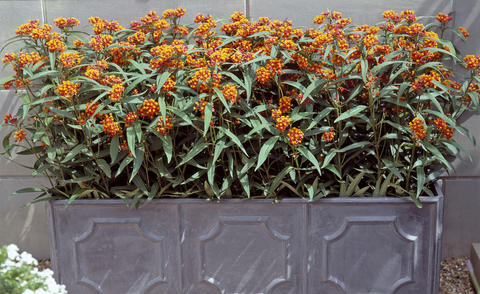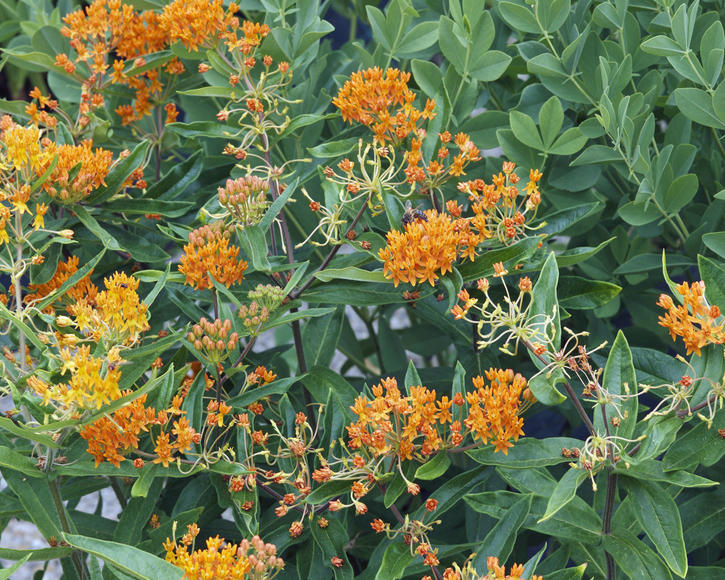Butterfly Weed
Bright orange flowers, a unique decorative fruit, and a favorite of butterflies: Butterfly weed is a gem in any natural garden.
Factsheet
- Growth type
-
- Perennial plant
- Growth height (from)
- from 50 cm to 100 cm
- Growth width (from)
- from 45 cm to 50 cm
- Growth characteristics
-
- upright
- horst-forming
- Flower color
-
- orange
- Flowering time (month)
-
- June to August
- Flower shape
-
- umbel-like
- Flower characteristics
-
- strongly fragrant
- Leaf color
-
- green
- page format
-
- narrow lanceolate
- pointed
- Fruit color
-
- brown
- yellow
- Fruit shape
-
- Capsule
- Light
-
- sunny to semi-shade
- Soil type
-
- sandy to loamy
- Soil Moisture
-
- dry to fresh
- ph value
-
- neutral to weakly acidic
- Lime compatibility
-
- sensitive to lime
- Nutrient requirements
-
- moderately nutritious
- Humus
-
- rich in humus
- Decorative or utility value
-
- Flower Decoration
- Scented plant
- medicinal plant
- Nectar or pollen plant
- Winter Hardness
-
- hardy
- Climate zones according to USDA
-
- 8
- areas of life
-
- FR2
- Use
-
- Flowerbeds
- Planters
- Rebates
- Garden style
-
- natural garden
- Stone Garden
- Pot garden
Butterfly weed (Asclepias tuberosa) is native from southern Canada to northern Mexico. Here, this relatively winter-hardy species grows on dry fields and embankments. The Asclepias genus has around 200 species that are either shrubs or upright subshrubs, many of which are found in Africa as well as America. You should keep in mind that many Asclepias are sold under the name “Milkweed”, with some grown as container plants or. So you should therefore always check the winter-hardiness when making a purchase.
These horst-forming deciduous milkweeds grow to between 20 and 40 inches tall. The strong, branchless shoots of this shrub excrete a milky substance. This is said to have similar properties to digitalis, causing cardiovascular symptoms. The rootstock penetrates the soil deeply. Asclepias tuberosa is usually winter hardy.
The narrow, lanceolate, undivided leaves are furry underneath and are arranged in spirals at irregular intervals upon the shoot. They are 3.94 to 5.51 inches long, pointed, shiny and light to medium green. At the base, they either envelope the stalk or have a short stem.
The flat, terminal or axillary umbel-like flowers are up to 3.94 inches wide, boasting shades of orange though sometimes yellow and red. The glossy green foliage provides an ideal backdrop. The flowers of the Butterfly weed give off an enchanting scent. They appear in July, flowering right through to early fall. Its backwards-tilting corolla lobes are particularly striking.
Asclepias tuberosa’s fruit capsules sit on nodding stems, and are flat and spindly. Initially green, they later turn a yellow-brown. When opened, they reveal a bushel of long, silky, silver hairs at the end for a very distinctive look. The genus is called milkweed in English due to the milky substance the plants excrete.
Butterfly weed requires full sun, but also tolerates light shade. Even longer period of dryness are tolerated well.
The soil may be permeable, rich in hummus and dry to fresh. The Butterfly weed prefers slightly acidic soil, and lime should be avoided. Winter hardiness will suffer in waterlogged soil.
Asclepias tuberosa will thrive in a well-protected location. The prerequisite for good growth is deep, loose soil that can be enriched with organic material. is particularly necessary if there is the slightest hint of waterlogging in the soil. All root-spreading weeds should be carefully removed before planting. Water regularly after planting.
As long as the location’s conditions are right, the Butterfly weed needs very little care. Dead heads should be removed to encourage a longer flowering period. A light spreading of compost in spring is all the fertilization required. The plant should be cut back to around a hand’s width above the ground, but not before spring as the seed heads look charming over winter. It may be necessary to cut back seed heads to prevent self seeding.
Ideally, the Asclepias tuberosa should be divided in spring to rejuvenate it. But this is only necessary every eight to ten years. To divide, dig up the rootstock and separate it into segments, not too small, then plant these back into the bed.
A planted Butterfly weed will benefit from being covered with a little compost in fall – especially to protect it from black frost.
The Butterfly weed is commonly used in nature gardens, in borders or in open spaces. It also looks great in stone beds. It should ideally stand proud, with no taller plants around. Asclepias tuberosa is excellent for pairing with grasses, echinacea, blue wild indigo or coppertips as these flower at the same time. Butterfly weed also looks fabulous in pots on a terrace.

If you plan on using the flowers for a bouquet, you should wear gloves while cutting as the latex excretion can cause skin irritation. As an Asclepias tuberosa is said to help with chest infections, diarrhea and rheumatism. The leaves are used to brew a tea for bronchitis.
Subspecies Asclepias tuberosa subsp. interior is the most winter hardy version we offer. The variety “Gay Butterfly” offers colorful yellow, orange and red flowers, while “Hello Yellow” boasts rare shades of yellow.
When sown, Asclepias tuberosa seeds should only be pressed into the potting soil. It is advisable to sow in propagators from March, but the seeds may be sown direct in April/May or fall. The germination rate can be increased by stratifying the seed. Propagation through cuttings is also possible.
are rarely a problem. A greater concern with butterfly weed is excess moisture, which can cause roots to rot.

